Creating SQL Database Table
This database contains one table named test.
CREATE TABLE [dbo].[TestTable](
[Name] [varchar](50) NULL,
[Email] [varchar](100) NULL
)
Now press F5 to execute the script above that looks like this:

.ASPX Page
Right-click
your ASP.NET project then select "Add New Item" -> "New Page" and
give it the name "Default.aspx" and add the following control into it:
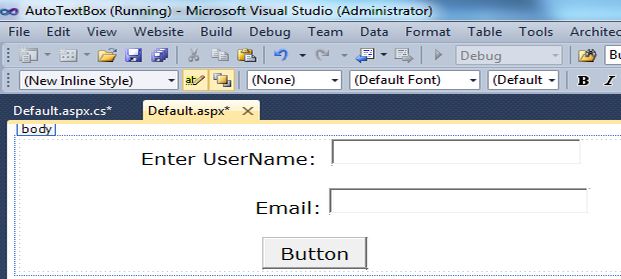
Now click on the source tab and add the following code:
<%@ Page Language="C#" AutoEventWireup="true" CodeFile="Default.aspx.cs" Inherits="_Default" %>
<!DOCTYPE html PUBLIC "-//W3C//DTD XHTML 1.0 Transitional//EN" "http://www.w3.org/TR/xhtml1/DTD/xhtml1-transitional.dtd">
<html xmlns="http://www.w3.org/1999/xhtml">
<head id="Head1" runat="server">
<title>AutoComplete Box with jQuery</title>
<link href="http://ajax.googleapis.com/ajax/libs/jqueryui/1.8.1/themes/base/jquery-ui.css"
rel="stylesheet" type="text/css" />
<script type="text/javascript" src="http://ajax.googleapis.com/ajax/libs/jquery/1.4.2/jquery.min.js"></script>
<script type="text/javascript" src="http://ajax.googleapis.com/ajax/libs/jqueryui/1.8.1/jquery-ui.min.js"></script>
<script type="text/javascript">
$(document).ready(function () {
$('#Button1').click(function () {
$.ajax({
type: 'POST',
contentType: "application/json; charset=utf-8",
url: 'Default.aspx/InsertMethod',
data: "{'Name':'" + document.getElementById('txtUserName').value + "', 'Email':'" + document.getElementById('txtEmail').value + "'}",
async: false,
success: function (response) {
$('#txtUserName').val('');
$('#txtEmail').val('');
alert("Record Has been Saved in Database");
},
error: function ()
{ console.log('there is some error'); }
});
});
});
</script>
</head>
<body>
<form id="form1" runat="server">
<div class="demo">
<div class="ui-widget">
<label for="tbAuto">
Enter UserName:
</label>
<asp:TextBox ID="txtUserName" runat="server" ClientIDMode="Static" Width="202px"></asp:TextBox>
<br />
<br />
Email: <asp:TextBox ID="txtEmail" runat="server" ClientIDMode="Static" Width="210px"></asp:TextBox>
<br />
<br />
<asp:Button ID="Button1" runat="server" Text="Button" ClientIDMode="Static" />
</div>
</div>
</form>
</body>
</html>
Now double-click on the default form and add the following .cs file code:
using System;
using System.Collections.Generic;
using System.Data.SqlClient;
using System.Web.Services;
using System.Web;
using System.Data;
public partial class _Default : System.Web.UI.Page
{
protected void Page_Load(object sender, EventArgs e)
{
}
[WebMethod]
public static string InsertMethod(string Name, string Email)
{
SqlConnection con = new SqlConnection("Data Source=.;Initial Catalog=TestDB;User ID=sa;Password=Micr0s0ft");
{
SqlCommand cmd = new SqlCommand("Insert into TestTable values('" + Name + "', '" + Email + "')", con);
{
con.Open();
cmd.ExecuteNonQuery();
return "True";
}
}
}
}
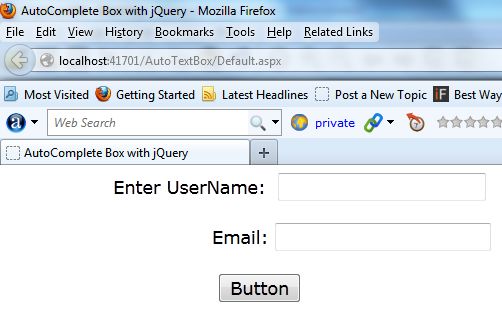
Now enter the name and email into the corresponding TextBox.
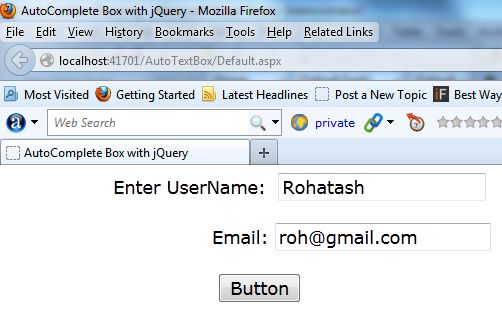
Now click on the Button control.
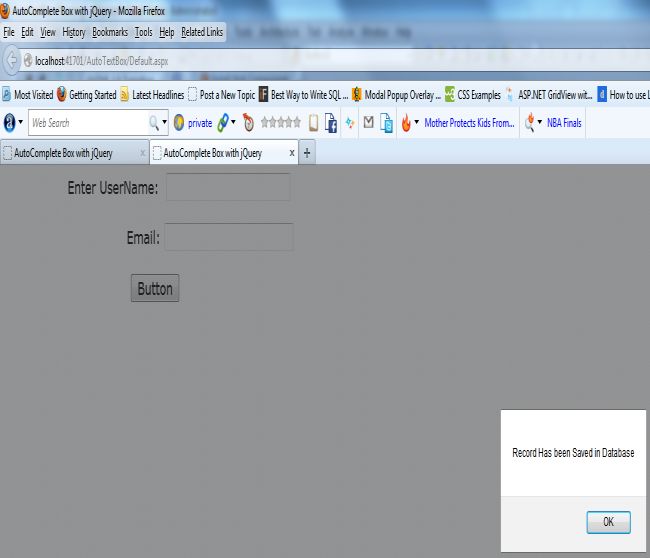
Now open the SQL Server database and check it.
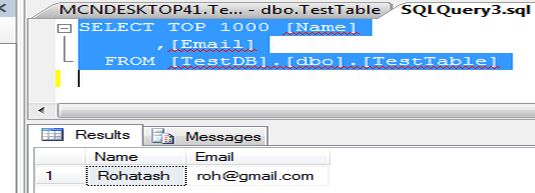

No comments:
Post a Comment